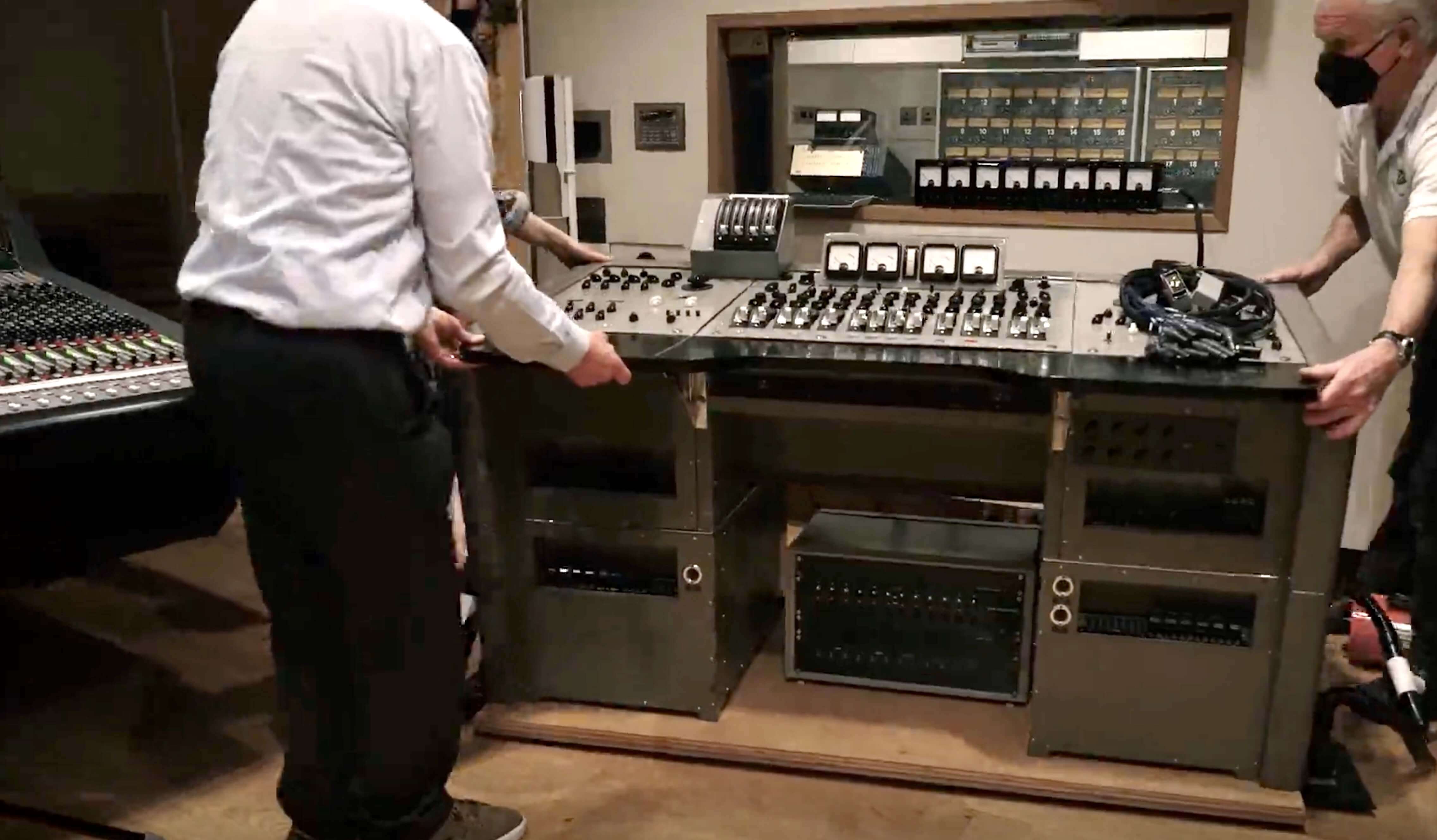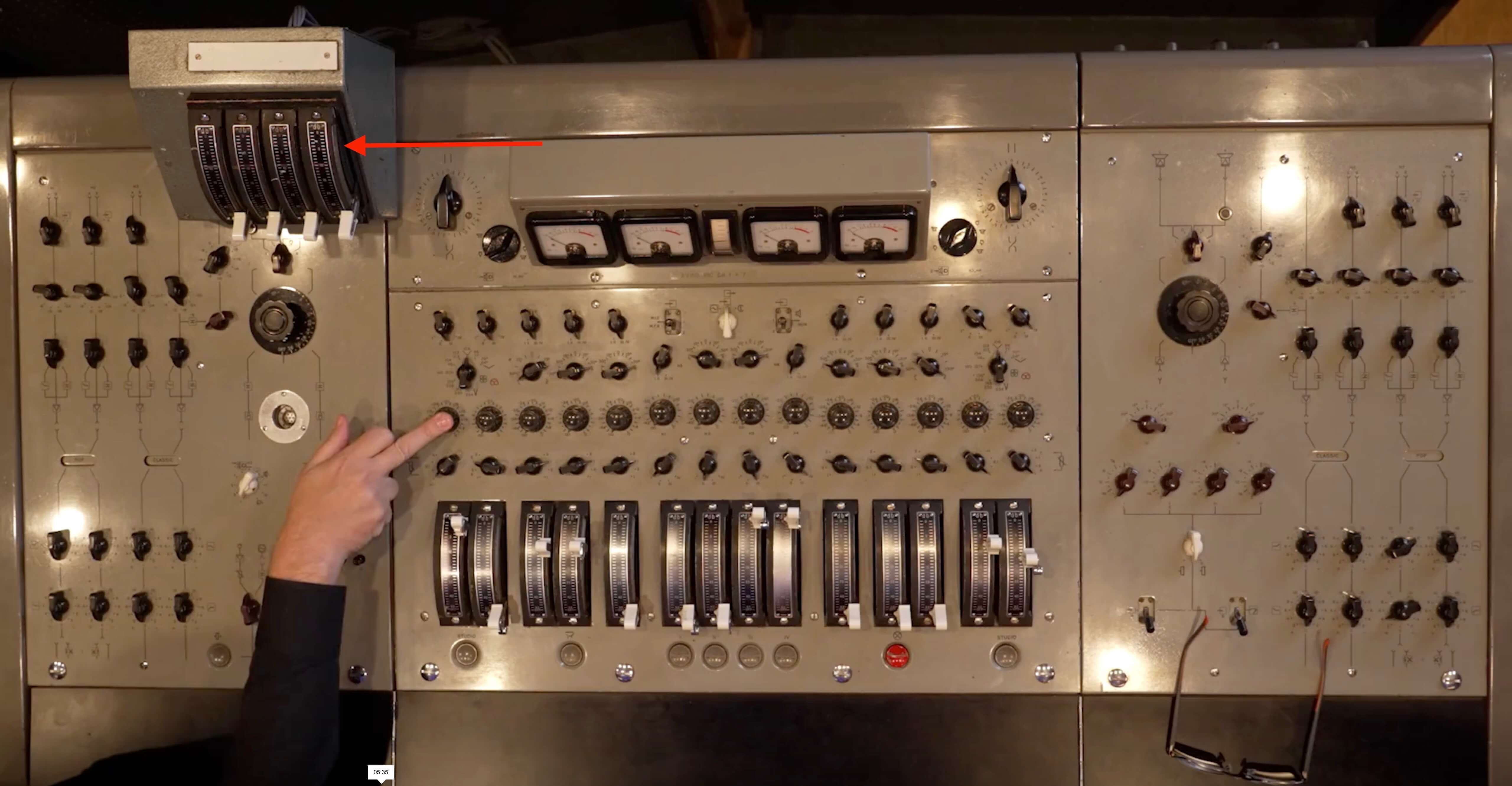The recording process was enormously different back when the Beatles made their first records at EMI Studios in London (which would later be renamed Abbey Road Studios) late in 1962. You’ll get a taste of how much things have changed if you watch Episode 7 of “Start to Finish: History of the Beatles Recording Techniques.” In it, Fab Dupont does a dive into the REDD.51, a tube-based console that was one of several REDD desks used at EMI in that era.
Heavyweight Champion
Designed in the late 1950s by EMI engineers, REDD (an acronym for Recording Engineer Development Department) consoles have become extremely rare and valuable. This episode takes place at Grove Studios in London, which is now home to the REDD.51 console that was formerly at EMI. In the video, Dave Harries explains the console’s features.

An overhead view of the REDD.51.
In the first scene, you see the studio staff moving the REDD.51, which weighs about 800 pounds, on a thick wooden plank that they push across the studio floor with the assistance of a hovercraft system. While it’s being moved, one of the assistants pumps compressed air into air casters underneath the plank, making it possible to slide the heavy mixing desk more efficiently.

Sliding the REDD.51 across the studio.
On the Way In
The console is split into three sections, input, main and monitor. It features eight mic input channels and, on the output side, can feed a four-track recorder.
Each input channel has two mic inputs and an A/B switch to toggle between them. With two mics connected to one channel, engineers could easily try alternate mics on the same source to see which sounded better.
In addition, the cluster of faders on the upper left-hand side of the console is a passive mixer on the input stage, which can handle four mics and mix them to a mono output. Harries says the passive mixer was often used on string sections, allowing the engineer to hang four mics but output only one channel into the recorder. (When the console was designed in 1957, most recorders were two-track, and no four-track machines were available yet.)

The arrow points to the 4x1 passive mixer in the input section.
Each channel of the input section features a tube pre-amplifier, a DI input, a pad and a two-band EQ. The high-frequency band of the EQ can be configured for Pop or Classical applications, each of which uses a different module. The former has a peaking filter at 5 kHz, and the latter has a shelf at 10 kHz.

Flipping one of the input section’s A/B switches.
Dave says that in the early Beatles era, only the Pop modules were allowed to be used on pop records. He says the Classical module created too much high-end information, which could be problematic during the vinyl mastering stage.
The main section sports faders for each channel. After the fader are four switchable outputs, allowing the engineer to route the signals to a specific track on a four-track or two-track mixdown deck. A cluster of four faders in the center of the desk control levels going to tape.
The main section also features echo sends for each channel, with flexible routing.
It’s Modular
Not only are there removable modules in the EQ section, but the preamps also slide out (presumably for maintenance). If needed, the console can be broken down into five pieces for transport.

Sliding out a preamp module.
The REDD.51 was the last REDD console to be made, and it differed from its predecessor, the REDD.37, in one crucial respect. The REDD.37 featured classic Siemens V72 preamps, but the REDD.51 had units built by EMI. According to Mirek Styles, Abbey Road Studio’s Head of Products, EMI asked the REDD developers to build their own preamps as a cost-saving measure due to the high cost of the V72s.
Not only do the EQ modules slide out, but the amplifiers do too, making it a lot easier to maintain them.
Some other cool features include a processor insert slot—for connecting a hardware processor and a patchbay built into the back of the unit.
At several points in the video, Harries opens up the top panel of the input section, which, like the other two sections, is designed to flip open. When he does, you see the wiring inside it and realize how incredibly complicated it must have been to design and build this unit. It’s pretty impressive, albeit somewhat anachronistic.

A look inside with the cover open.
REDD Plugins
Although Fab had the privilege of working with a REDD.51 for this video, the closest most of us will get to a REDD desk is the Waves Abbey Road REDD Consoles plugin collection, which offers emulations of all three REDD consoles: the REDD.17, REDD.37 and REDD.51. The product includes two plugins: the REDD.17 and the REDD.37-51. The latter combines emulations of the REDD.37 and REDD.51 and lets you switch between them.

The Waves REDD.37/51 plug-in.
To give you a taste of what the Waves REDD.37/51 can do, here are a couple of examples that feature drums, bass, two rhythm guitars doubling each other, and a melody guitar.
In the first example, there’s no Waves REDD Console processing.
In this version, every track has a Waves REDD.37/51 plug-in, and most have the drive turned up to some extent. The processing warms up the mix overall.